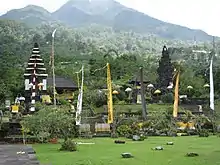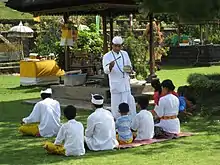Pura Parahyangan Agung Jagatkarta
Pura Parahyangan Agung Jagatkarta ("the perfect divine nature")[1] or often referred to simply as Pura Jagatkarta is a Hindu temple of Nusantara located in Ciapus village, Tamansari subdistrict, Bogor Regency, West Java, Indonesia. Once completely built, Pura Jagatkarta became the largest temple in West Java and the second largest in Indonesia after Pura Besakih in Bali.[2]
| Pura Parahyangan Agung Jagatkarta | |
|---|---|
 | |
 | |
| General information | |
| Type | Pura Kahyangan Jagad |
| Architectural style | Balinese |
| Address | Ciapus village, Tamansari subdistrict, Bogor Regency, West Java, Indonesia |
| Country | Indonesia |
| Coordinates | 6°40′10″S 106°44′07″E |
| Elevation | 780 meter |
The temple complex is a sacred place of worship, served as Pura Kahyangan Jagad,[3] a type of pura that are located in the mountainous region, for Hindu Dharma devotees in Greater Jakarta area. It is also considered as a sacred place to honor the hyang (deified ancestral spirits) identified as King Siliwangi of Pakuan Pajajaran kingdom, an ancient Hindu kingdom which once stood in the Parahyangan area.[2]
Layout

Pura Jagatkarta is located at the northern slope of Mount Salak, in Ciapus, Tamansari subdistrict in Bogor Regency. Pura Jagatkarta is built on a sacred location in Mount Salak because it is believed that Pakuan Pajajaran Sunda kingdom stood in the location. Historically, Pakuan Pajajaran (now Bogor) is the capital of the Sunda Kingdom, which was one of the last Hindu kingdom in Java (along with Majapahit) which experienced its golden age under the rule of King Siliwangi, before being conquered by Javanese Muslims in the 16th century.[4]
The construction of Pura Jagatkarta is also based on the legend that the area is the place where Prabu Siliwangi reached moksa with his soldiers. Before the temple compound was built, a candi temple with white and black tiger statue (believed to be the symbol of Prabu Siliwangi) was established as a tribute to the Pajajaran Kingdom, the last Hindu kingdom In the land of Parahyangan.[5]
The access road from the foot of Mount Salak to Pura Jagatkarta has been widened since its construction was pioneered in 1995, so vehicles can reach the temple easily. But because of the many visitors who come, the parking area is located far from the temple area.
Development

The construction of Pura Jagatkarta was started in 1995 initiated by a mutual cooperation of Hindu Nusantara community to provide a Pura Kahyangan Jagad temple for the Balinese Hindu community resident in the Greater Jakarta area to enable them to complete the whole rituals required in the Hindu Dharma religion. Currently the Pura Jagatkarta temple compound is not completed yet. However, the main temple buildings in Mandala Utama such as Padmasana, Balai Pasamuan Agung, and Paduraksa gates have been completed.
Before entering the main area of Pura Jagatkarta there is also Pura Melanting and Pura Pasar Agung which is used specially for praying, perfecting, and sanctifying the offerings that will be presented in Pura Jagatkarta as a form of gratitude. Tourist visitors are generally prohibited from entering the main temple, except for those who want to perform ritual praying, otherwise access is only available to the outer court temple.[6]
See also
| Wikimedia Commons has media related to Pura Parahyangan Agung Jagatkarta. |
References
- Laman Pura di Situs Pemerintah Kabupaten Bogor, diakses 12 December 2013.
- Media, Kompas Cyber (2016-11-05). "Ini 5 Destinasi Tersembunyi di Lereng Gunung Salak - Kompas.com". KOMPAS.com (in Indonesian). Retrieved 2018-05-18.
- "Babad Bali - Pura Kahyangan Jagat". www.babadbali.com (in Indonesian). Retrieved 2018-05-20.
- Ricklefs, M.C. (1991). A History of Modern Indonesia since c.1300, 2nd Edition. London: MacMillan. ISBN 0-333-57689-6.
- "Wangsit Gaib Prabu Siliwangi di Pura Jagatkartta Bogor". detikTravel (in Indonesian). Retrieved 2018-05-18.
- Gumilar, Gun Gun. "Pengunjung Wisatawan Pura Tamansari Bogor Dibatasi" (in Indonesian). Retrieved 2018-05-18.